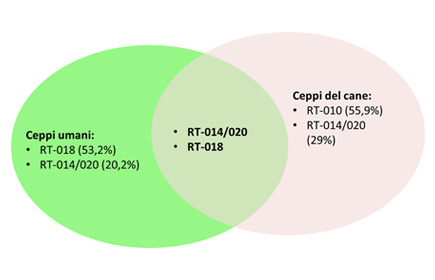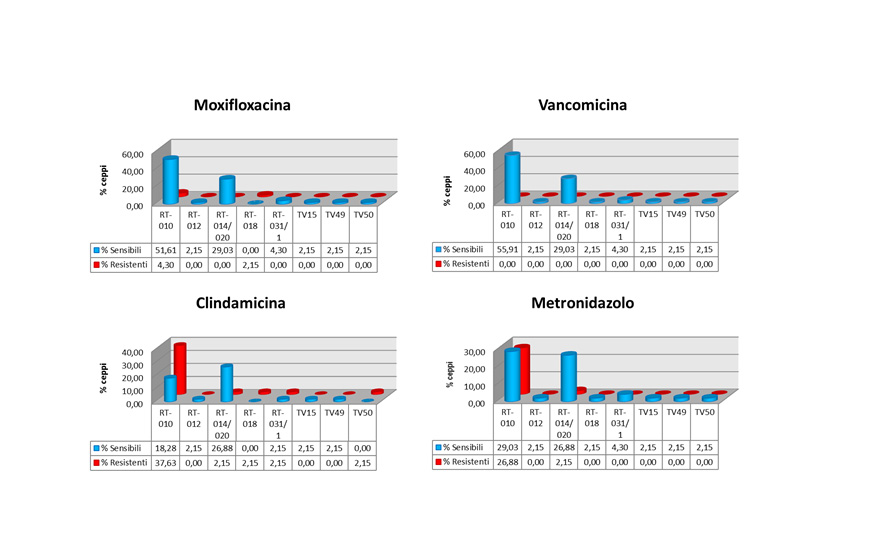
Clostridium difficile is a bacterium isolated in many animal species. Epidemiological studies have shown a substantial similarity between these strains and those isolated in humans.
Human infections of Clostridium difficile are historically considered to be a hospital pathology that causes diarrhoea, abdominal pain, and in the worst cases fever and dysentery.
Recently, however, a drastic change in the epidemiology of this infection has been witnessed: the number of cases and the mortality rate has shown a marked increase even outside the hospital environment, thereby affecting subjects previously considered not at risk such as young people and pregnant women.
One of the possible reasons for this increase could be due to greater exposure to C. difficile through contact with animals that carry and eliminate the pathogen, as well as with the consumption of contaminated animal products.
In fact, the bacteria was isolated in many animal species, both pets and farm animals, and molecular epidemiology studies have shown a substantial similarity between these strains and those isolated in humans.
Animal to human transmission
However, the possibility of animal-to-human transmission needs further study, in particular to define the likely role of pets as vectors, especially in light of the spread of pet therapy practices.
Living in close contact with humans and sharing their spaces, pets, especially dogs, can represent a serious risk factor in particular for certain categories of people such as the elderly and immune-suppressed.

Pets, especially dogs, can represent a serious risk factor in particular for certain categories of people such as the elderly and immune-suppressed.
In the presence of individual carriers and eliminators of C. difficile, in fact, there may be a persistent environmental contamination, due to the ability of C.difficile to produce spores which can then be ingested by humans, thus creating conditions for infection and possibly disease.
IZSVe Research
In light of this scenario, the Treviso section of the Istituto Zooprofilattico Sperimentale delle Venezie carried out a survey on the epidemiology of Clostridium difficile by phenotypic and molecular characterization of isolates of dog and humans, in order to obtain preliminary indications on the possible transmission of the pathogen from dog to humans, including antimicrobial-resistant strains (research project RC 13/10).
The IZSVe research project has developed on several fronts and aims to:
- build a collection of C. difficile strains isolated from dogs, using samples taken from public or private kennels, from veterinary surgeries and clinics in the Veneto Region and from dogs used for pet therapy
- build a collection of C. difficile strains isolated from human samples and collected from the microbiology departments of the hospitals in the Veneto Region
- characterize phenotypically (considering antimicrobial susceptibility) and genetically (by defining the molecular characteristics and the ability to produce toxins) of C. difficile strains isolated during the research project.
During the project 143 human faecal samples were collected that already registered positive for C. difficile in hospital laboratories, and 996 from dogs. In total 226 strains of C. difficile were isolated: 133 human and 93 dog.
Results
Ribotypes
In humans 15 different ribotypes (RT) have been highlighted, with a clear majority of RT-018 (53.2%) and RT-014/020 (20.2%).
In dogs 8 different ribotypes were identified: the most frequent was RT-010 (55.9%), non-toxigenic, followed by RT-014/020 (29%), which instead is a producer of toxins.
The latter is therefore commonly isolated in both dogs and humans, and in Europe it represents the ribotype most frequently associated with human infections.
Finally, 70% of the strains isolated from dogs are non-toxic, and therefore are not able to induce disease in carrier subjects.
Antimicrobial Resistance
The sensitivity to certain antimicrobials used in human medicine for the treatment of infections by C. difficile was then evaluated: clindamycin, moxifloxacin, metronidazole and vancomycin. The analysis of strains isolated from dogs showed a high percentage of strains resistant to clindamycin (46.24%) and metronidazole (29%), while only a small number of strains (6.4%) demonstrated to be resistant to moxifloxacin.
The most resistant strains belong to RT-010. Metronidazole is for humans the antibiotic of choice for the treatment of mild to moderate infections by C. difficile. Although the resistance mechanisms are not yet clear, the spread of these strains and the possible transferability of resistance to C. difficile pathogenic strains definitely deserve attention.
Method for detecting DNA
Finally, during the course of the research project a method in real time PCR for the detection of the presence of DNA of C. difficile was devised that can usefully incorporate the traditional bacteriological investigation protocols. The developed method was highly specific and markedly more sensitive than the classic microbiological method, and therefore suitable for use as a screening method of faeces in a culture medium.
In conclusion
The results showed that dogs might be a carrier of C. difficile and there is a partial overlapping of the toxigenic strains of C. difficile isolated from man and dog. These results highlight the possibility that dogs can transmit toxigenic strains of C. difficile to humans.
The isolates from the dog are also characterized by high levels of resistance to clindamycin and metronidazole, the main antimicrobials used in therapy of human infections by C. difficile.
Given the close contact that often exists between dogs and man, it is therefore desirable to screen the animals which may come into contact with people at risk, such as immune-suppressed individuals and the elderly, in order to prevent the occurrence of infections that in these patients may give rise to the disease (pseudomembranous colitis) characterized by a development that is particularly severe and often fatal.









